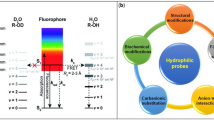Abstract
Photo-activated or “Caged” rhodamine dyes are the most useful for microscopic investigation of biological tissue by various fluorescent techniques. Novel precursor of the fluorescent dye (PFD813) has been studied for photosensitive staining of numerous animal cells. The functional rhodamine dye (Rho813) with intensive fluorescence has been obtained after photoactivation of its precursor PFD813 inside cells. The dye Rho813 has been successfully used for the optical detection of particular features in biological objects (HaCaT cells, HBL-100, MDCK, lymphocytes). Moreover, the chitosan conjugate with PFD molecules (“Chitosan-PFD813″) has been obtained and studied for the first time. The developed procedures and obtained data are important for further applications of novel precursors of fluorescent dyes (“caged” dyes) for microscopic probing of biological objects. As example, the synthesized “Chitosan-PFD813″ has been successfully applied in this study for intracellular transport visualization by fluorescent microscopy.






Similar content being viewed by others
References
Grimm, J. B., Heckman, L. M., & Lavis, L. D. (2013). The chemistry of small-molecule fluorogenic probes. Progress in Molecular Biology and Translational Science, 113, 1–34.
Haugland, R. P., Spence, M. T. Z., Johnson, I. D., & Basey, A. (2005). The handbook: a guide to fluorescent probes and labeling technologies (10th ed.). Eugene: Molecular Probes.
Lavis, L. D., & Raines, R. T. (2008). Bright ideas for chemical biology. ACS Chemical Biology, 3, 142–155.
Beija, M., Afonso, C. A., & Martinho, J. M. (2009). Synthesis and application of rhodamine derivatives as fluorescent probes. Chemical Society Reviews, 38, 2410–2433.
Foelling, J., Belov, V., Riedel, D., Schoenle, A., Egner, A., Eggeling, C., et al. (2008). Fluorescence nanoscopy with optical sectioning by two-photon induced molecular switching using continuous-wave lasers. ChemPhysChem, 9(2), 321–326.
Wysocki, L. M., Grimm, J. B., Tkachuk, A. N., Brown, T. A., Betzig, E., & Lavis, L. D. (2011). Facile and general synthesis of photoactivatable xanthene dyes. Angewandte Chemie International Edition, 50, 112016–112019.
Mitchison, T. J., Sawin, K. E., Theriot, J. A., Gee, K., Mallavarapo, A., & Manion, G. (1998). Caged fluorescent probes. Methods in Enzymology, 291, 63–79.
Belov, V. N., Bossi, M. L., Foiling, J., Boyarskiy, V. P., & Hell, S. W. (2009). Rhodamine spiroamides for multicolor single molecule switching fluorescent nanoscopy. Chemistry A European Journal, 15, 10762–10776.
Zaitsev, S. Y., Belov, V., Mitronova, G. Y., & Moebius, D. (2010). Mixed monolayers of a novel rhodamine derivative. Mendeleev Communications, 20, 203–204.
Lavis, L. D., Grimm, J. B., Wysocki, L. M., Tkachuka, A. N., Browna, T. A., & Betziga, E. (2012). Facile syntheses of photoactivatable rhodamines. Microscopy and Microanalysis, 18, 668–669.
Politz, J. C. (1999). Use of caged fluorochromes to track macromolecular movement in living cells. Cell Biology, 9, 284–287.
Banala, S., Maurel, D., Manley, S., & Johnsson, K. (2012). A caged, localizable rhodamin derivative for superresolution microscopy. ACS Chemical Biology, 7, 289–293.
Wei, Y., Aydin, Z., Liu, Z., & Guo, M. (2012). A turn-on fluorescent sensor for imaging labile Fe3+ in live neuronal cells at subcellular resolution. ChemBioChem, 13, 1569–1573.
Hell, S. W. (2007). Far-field optical nanoscopy. Science, 316, 1153–1158.
Foelling, J., Belov, V., Kunetsky, R., Medda, R., Schoenle, A., Egner, A., et al. (2007). Photochromic rhodamines provide nanoscopy with optical sectioning. Angewandte Chemie International Edition, 46, 6266–6270.
Boyarskiy, V. P., Belov, V., Medda, R., Hein, B., Bossi, M., & Hell, S. W. (2008). Photostable, amino reactive and water-soluble fluorescent labels based on sulfonated rhodamine with a rigidized xanthene fragment. Chemistry-A European Journal, 14, 1784–1792.
Belov, V., Wurm, C. A., Boyarskiy, V. P., Jakobs, S., & Hell, S. W. (2010). Rhodamines N N a novel class of caged fluorescent dyes. Angewandte Chemie International Edition, 49, 3520–3523.
Zaitsev, S Yu., Shaposhnikov, M. N., Solovyeva, D. O., Zaitsev, I. S., & Mobius, D. (2013). Novel precursors of fluorescent dyes. 1. Interaction of the dyes with model phospholipid in monolayers. Cell Biochemistry and Biophysics, 67(3), 1365–1370.
Zaitsev, S. Y., Shaposhnikov, M. N., & Svirshchevskaya, E. V. (2010). Staining of cells by new photoactivated fluorescent dyes. Veterinary Medicine, 3–4, 32–34. (in Russian).
Shaposhnikov, M. N., Chudakov, D. B., Generalov, A. A., Savina, A. A., & Zaitsev, S. Y. (2012). The fluorescence dependence of a new photoactivatable dye on the environment parameters. Fundamental Research, 9(2), 322–327. (in Russian).
Shaposhnikov, M. N., Chudakov, D. B., Generalov, A. A., & Zaitsev, S. Y. (2012). Preparation of chitosan conjugate with photoactivatable fluorescent dye and its application in cell microscopy. Veterinary Medicine, 3–4, 32–35. (in Russian).
Zaitsev, S. Y. (2010). Supramolecular nanodimensional systems at the interfaces: concepts and perspectives for bio nanotechnology (in Russian). Moscow: LENAND.
Zaitsev, S. Y. (2009). Membrane nanostructures on the basis of biologically acitive compounds for bionanotechnological purposes. Nanotechnologies in Russia, 4, 379–396.
Acknowledgments
Some parts of this work were supported by grant from Russian Scientific Foundation (Project 14-16-00046). We thank Dr. Svirshchevskaya E.V. and Ph.D.-student Generalov A.A. for cell cultivation and suggestions on cell staining experiments; Dr. Belov V. N. for preparation of the precursor of fluorescent dye.
Author information
Authors and Affiliations
Corresponding author
Rights and permissions
About this article
Cite this article
Zaitsev, S.Y., Shaposhnikov, M.N., Solovyeva, D.O. et al. Cell Staining by Photo-activated Dye and Its Conjugate with Chitosan. Cell Biochem Biophys 71, 1475–1481 (2015). https://doi.org/10.1007/s12013-014-0370-1
Published:
Issue Date:
DOI: https://doi.org/10.1007/s12013-014-0370-1




